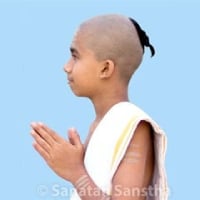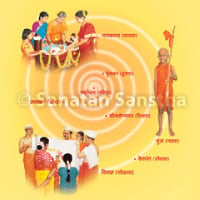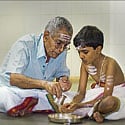Before commencing any sanskars, certain rituals are performed in order to prevent any obstacles from disrupting the auspicious occasion. These are called supporting rituals. Deities are invoked, praised and prayers are offered so as to attract auspicious forces and combat inauspicious forces.
Whenever sanskars are performed, there is a possibility of negative energies attacking the one on whom the sanskar is performed. Supporting rituals are therefore performed before commencing the ritual of sanskars. This ensures good frequencies to move in a specific manner around the venue of the sanskar ceremony as well as the individual on whom the sanskar is being performed. It is also a remedy to ward off the ghosts and spirits.
1. Method of celebration
Two or three days prior to performing the sanskars, the house should be painted. A picture of Shri Ganapati should be installed at the main door and a pandal should be erected. After smearing the floor with cow dung, designs of auspicious symbols such as the swastik, lotus etc. should be drawn using rangoli. Before the ceremony of the sanskar, the one on whom the sanskar is to be performed, as well as the relatives, should wear new clothes and ornaments and should present gifts to the one on whom the sanskar is being performed.
2. Sanskars and supporting rituals
Every sanskar is commenced with :
-
Shri Ganapati-puja
-
Punyahavachan
-
Matrukapujan
-
Nandishraddh
-
Acharyavaran
Only after performing these, the specific sanskar is begun. The relative importance of the supporting rituals and the sanskars is as follows :
| Sanskar | Importance % |
|---|---|
| 1. Supporting ritual | 5 |
| 2. Sanskars | 95 |
| Total | 100 |
Since the importance of each supporting ritual is 1%, the sum total of the five is 5%.
Percentages given in the table have been received by His Holiness Dr. Jayant Athavale (Sanatan’s source of inspiration) in meditation.
3. Importance of the sankalpa (Resolve)
Every ritual is begun with a sankalpa as it contributes 70% towards the benefit derived from the ritual. On the other hand only 30% is attributed to performing the ritual. Despite this being so, the actual ritual is important as a mere sankalpa does not bestow bliss, while an act does. Consequently, one mentally resolves to perform the ritual again.
4. Supporting rituals
Supporting rituals mean ‘Adhar-vidhi’ in Sanskrut. The word ‘vidhi’ has evolved in the form ‘विशेषेण धीयते’. It means doing something by which the good frequencies called ‘dhee’ will move in a specific manner.
A. Shri Ganapati-pujan
1. Objectives : To prevent any obstacle from disrupting an auspicious occasion, it is begun with the worship of Shri Ganapati, a practice that is prevalent since the last century.
2. Preparations :
-
Bath : The host and hostess performing the religious ceremony should bathe and wear clean attire.
-
The seat : The floor should be wiped clean, smeared with fresh cow dung and two or three wooden seats should be placed on it. Woollen cloth should be spread on these seats and the sides should be decorated with designs drawn with rangoli. The energy generated in the body because of the wooden seat and woollen cloth during worship, instead of escaping into the ground instantly, is conserved in the body for at least sometime.
-
Taking the seat : The host and hostess performing the religious ceremony should sit facing the east, as this direction is considered to be auspicious. The wife should be seated to the left of her husband. The left side of the husband indicates the Chandranadi (Moon channel). When the wife sits on the side of Chandranadi, there is not much activation of energy. In this ritual, activation of energy is undesirable. It is the experience of bliss that is desirable. The one on whom the sanskar is to be performed should sit to the left of the hostess.
-
Gandh-dharan : Married women should apply a tilak of gandh (Sandalwood paste) onto the foreheads of the host and hostess performing the religious ceremony, the one on whom the sanskar is being performed and the guests. The energy generated due to the ritual of worship which flows through the Adnya-chakra of the one performing the worship is increased by 5% when gandh is used. It also obstructs the entry of negative energy through the Adnya-chakra to the extent of 5%. Of the pleasant or negative energies entering the body, 30% do so through the Adnya-chakra.
-
Married women represent manifest energy, while unmarried girls represent unmanifest energy. The gandh applied by married women is more effective, as due to the manifest energy in them, it facilitates the increase of the sattva component in the one on whose forehead they apply the gandh. On auspicious occasions, widows do not apply tilak to others, as the quantity of manifest energy in them has reduced with end of married life.
-
Achaman : The host performing the religious ceremony should take a little water from the panchapatri with a pali onto his palm and sip it. This act is called a Just as bathing causes external purification, partaking water in this way is responsible for internal purification. Often this act is repeated thrice.
-
Wearing the pavitra or pavitrak (A sacred ring) : The host performing the religious ceremony should wear if possible a pavitrak made of gold or alternatively a ring made of darbha. As a result, pavitrak in the atmosphere get attracted towards the host in greater quantity. Pavitrak are the subtle most particles of Chaitanya (Divine consciousness) of various Deities.
-
Pranayam : Due to pranayam, the Raja component decreases and the Sattva component increases.
-
Salutation to the Ishtadevata (Benevolent Deity) and the Kuladevata (Family Deity) : One should pay obeisance to them by offering fruit and betel leaves with betel nut, lime, cardamoms etc. Thus, one gets their blessings too.
-
Achaman : One should perform achaman and subsequently perform pranayam by sipping water from the palm, while chanting each Name out of the twenty-four Names of Shrivishnu, commencing with ‘Keshav’.
3. Sankalpa
-
Holding akshata (Unbroken rice grains) and an offering of a spoonful of water in the cup of the hand the host should recite the mantra with the sankalpa – “I of the …..gotra (Lineage), ….. Sharma am performing the …. ritual to obtain the benefit according to the Shrutis, Smrutis and Puranas in order to acquire …. result” and then should offer the water from the hand into the tamhan. Offering the water into the tamhan signifies the completion of the act. (Sharma refers to the Brahman, Varma to the Kshatriya, Gupta to Vaishya class and Das to the Shudra )
-
Installation of the idol : A betel nut washed with water should be placed on a small heap of rice. (In Goa, instead of betel nut a coconut is used.) This is similar to the installation of the idol of Shri Ganapati, which is done on rice, heaped up on a wooden seat during the festival of Shri Ganesh Chaturthi. In a religious ritual, rice refers to akshata. Rice grains have the ability to attract very distant pavitrak. Betel nut too possesses the potential of attracting them from both male and female Deities. This potential is activated by a mantra.
Then, taking water again and expressing the sankalpa “I am performing Punyahavachan, Matrukapujan, Nandishraddh”, one should release the water into the tamhan.
In any religious ritual, the sankalpa plays a role in acquiring the benefit from the ritual.
4. Puja (Ritualistic worship)
-
Installation of the idol : A betel nut washed with water should be placed on a small heap of rice. (In Goa, instead of betel nut a coconut is used.) This is similar to the installation of the idol of Shri Ganapati, which is done on rice, heaped up on a wooden seat during the festival of Shri Ganesh Chaturthi. In a religious ritual, rice refers to akshata. Rice grains have the ability to attract very distant pavitrak. Betel nut too possesses the potential of attracting them from both male and female Deities. This potential is activated by a mantra.
-
The mantra to invoke Shri Ganapati : After saying, ‘गणानां त्वा गणपतिं हवामहे०’ the mantra ॐ भूर्भुवः स्वः ऋद्धिबुद्धिसहितं सांगं सपरिवारं सायुधं सशक्तिकं महागणपतिमावाहयामि । is recited which means ‘O great Shri Ganapati, come with riddhi (Wealth, prosperity), intellect, Your entire family, all Your weapons and might’. Then akshata should be offered to invoke Shri Ganapati on the betel nut. In between ‘ॐ भूर्भुवः स्वः’ is recited like the three step Gayatri-mantra. To prevent an obstacle of any sort in the ritual, Shri Ganapati is invoked with all His weapons and might.
-
Shodashopacharpujan : When any offering like naivedya, tambul or dakshina is made, one should repeatedly remind oneself, “This is not mine, I am offering unto You, what is Yours.” This is important from the point of view of making spiritual progress.
-
tamhan thus concluding the ritual.
B. Punyahavachan (Swastivachan)
1. Objectives : पुण्य (punya) + अह (aha) + वाचन (vachan) = पुण्याहवाचन (Punyahavachan) means getting the Brahmans to pronounce that the day of commencement of the ritual is an auspicious one. The day of commencing any auspicious ceremony is chosen after referring to the Hindu almanac. However, when the Brahmans proclaim the day to be auspicious and bless the host, it augments the benefits obtained from the day. Again, if a request is made to the Brahman for the well-being, prosperity, wealth fulfilment etc., then he blesses by saying, “So be it”.
2. Importance : Due to the recitation of mantras the day acquires energy
3. The material required :
- Those used for usual ritualistic worship
- Five foliages – branches of the Mango, Audumbar (Cluster fig tree), Pipal (Bo-tree), Jamun (Indian blackberry) and Banyan trees.
- Panchamrut – a mixture prepared out of milk, curd, ghee, honey and sugar.
- Five gems – gold, blue sapphire, ruby, emerald and pearl.
4. Preparation : The wife should sit to the right of the host and the one on whom the sanskar is to be performed should be seated to her right. The aim in sitting to the right of her husband, is to generate more energy during the ritual. The right side corresponds to the Sun channel.
5. Sankalpa : After pronouncing the name of the place and the time, a resolve is made and water is released in the tamhan by saying, ‘Under this worship I am performing Shri Ganapati- puja, Punyahavachan, Matrukapujan and Nandi-shraddh.’
6. Bhumi sparsh (Touching the earth) : Reciting the mantra, first the earth on the right side (since the host performing the religious ceremony is facing the east, the hand touching the ground is in the southern direction) and then the earth on the left side, in front (that is the northern direction) should be touched. Energies from the south are distressing. To prevent them from causing distress in the function, one offers obeisance to them by touching the earth. The energies from the northern direction are welfare bestowing and hence are saluted.
7. Kalash-sthapana (Installation of the pot) : Two small heaps of rice should be made on the ground amidst chanting of a mantra. Later, chanting the mantra two pots made either of gold, silver, copper or unbroken earthen pots should be placed on these two heaps.
- Tirthodak (Holy water) : Clean water either from rivers like the Holy Ganga or elsewhere should be filled in both the pots. Put gandha (Sandalwood paste) and durva in it. Then, put five foliages, betel-nut, five gems and dakshina in it one after another. In the end, perform sutraveshtan or tie a vastra to it
- Purnapatra (The water vessels) : One betel nut should be placed in each of the two vessels filled with rice. These vessels should be placed over the two pots as their lids. One of the pots symbolises the right side of Deity Varun and the other the left.
- After saying, ‘कलशे वरुणं सांगं सपरिवारं सायुधं सशक्तिकं आवाहयामि ।’ which means ‘The Deity of rain, Varun, please come along with Your entire family, all Your weapons and might’, akshata should be sprinkled on the betel nut. Then Deity Varun should be worshipped with five substances namely gandha, akshata, flowers, incense and a lit lamp.
Prayer made to the pot: ‘कलशस्य मुखे विष्णुः कंङ्गे रुद्रः समाश्रितः । मूले तत्रस्थितो ब्रह्मा मध्ये मातृगणा: स्मृता:।’ which means Shrivishnu is at the mouth, Deity Rudra at the neck and Deity Brahma at the bottom of the pot. In the middle are the assistants of the Matruka Deities, etc. Then akshata should be placed in the pot facing the north.
After paying obeisance to everyone saying मातृ देवो भव । पितृ देवो भव ।…….. सर्वेभ्यो देवेभ्यो नमो नमः । (that is obeisance to the Mother Deity, Father Deity, the benevolent Deity and all other Deities) one should sit with the knees touching the ground. Then cupping the hands in the shape of a lotus, the host should carry the pot facing the north and touch it to his forehead and that of his wife thrice. This is obeisance offered to the pot so as to be able to absorb the energy generated in it. The host should utter the sentences like ‘शांतिरस्तु’ etc. and release water in the tamhan placed in front. Then the priest should say, “May this day be an auspicious one. May there be well-being and prosperity and fulfilment of Shri Lakshmi (wealth)”. While reciting the niranjan mantra, married women wave a lit lamp in a circular motion in front of the host and hostess of the religious ceremony and the one on whom the sanskar is being performed. Then, lifting the right pot with the left hand and the left pot with the right, the water from it should be poured into a vessel in a continuous stream. The hostess should sit to the left of her husband and the priest should stand facing the north and should sprinkle water on the host and hostess of the ceremony and the one on whom the sanskar is being performed, with five types of foliages and durva, amidst chanting of mantras. Consequently, the energy generated in the pot is transmitted to all. Finally the host should perform achaman. This marks the end of the ritual.
C. Matruka- pujan
1. Objectives
-
It is a custom to worship the Matruka Deities along with Shri Ganesh at the beginning of any ceremony in order to prevent any obstacles. Matrukas are a type of female Deities and are twenty-seven in all.
-
Since Matrukapujan is a part of the ritual of Nandishraddha, it is performed along with the latter.
2. Puja : Twenty-seven small heaps of rice should be made and a betel nut should be placed on top of each of them. Ritualistic worship is performed as usual and then water is released to mark the end of the ritual.
D. Nandishraddha (Abhyudayik /Vruddhi-shraddha)
1. Objectives : The Nandishraddha is performed as an offering to the ancestors and their Deities (Nandimukh and others) just as Shri Ganesh is worshipped before commencing any auspicious ceremony to ward off any obstacle.
2. Preparations : In Nandishraddha (Vruddhishraddha) instead of one darbha, durva are used. However, if the shraddha is a part of the yadnya then grass without roots or a combination of both durva and darbha is used. Substances which have the ability to attract pavitrak of a Deity are used in the ritualistic worship of that particular Deity.
3. The ritual : Keep two tamhans facing each other. The one on right side is for the Deity and that on the left side is for departed ancestors. Release water in both the tamhans, for the sub-ritual of ‘padya’, gandha, flower and water together for the sub-rituals of asan, gandha etc. and dakshina for the sub-ritual of bhojan. Each of these acts needs to be performed with recitation of mantras. Similarly, to get the benefits of the Nandishraddha, one coin may be released in each of both the tamhans. One copper coin from the southern direction is an offering to the ancestors, in the region of ancestors situated in the south and to the distressing energies from that direction, so that they do not cause any trouble. Another copper coin is offered to benevolent Deities in the northern direction.
E. Acharyavaran (Accepting the priest)
While performing any of the sixteen sanskars, the rituals have to be performed only by the host, hostess and the person on whom sanskar is to be done. There are priests to recite mantras. Acharyavaran is necessary in the sanskars of thread ceremony and marriage only at the time of yadnya for planets. Other sanskars are to be performed only by the host, hostess and the person on whom sanskar is to be done. Acharyavaran is also done during the ritual of Bhuvaneshwari-shanti.
1. Objectives : Accepting the priest in order to perform any ritual.
2. Ingredients required : White mustard seeds, panchagavya.
3. The ritual : While reciting a mantra, the host keeps his right hand (facing downwards) on the right hand of the priest and requests him to be the officiating priest. (In certain areas, a betel nut is offered to the priest. This is a popular custom.) The priest then says “yes” and accepts the proposal. The host then prays to the priest to perform the ritual.
4. Prokshan (Sprinkling the ingredients with Holy water) : The ingredients required for the ritual and the place where the ritual is to be performed is sprinkled with panchagavya using durva or darbha. Also, to prevent spirits from causing any trouble, mustard seeds are scattered in all four directions.
Reference : Sanatan’s Holy Text ‘Sixteen Sanskars’

 Sanskar Meaning and Definition
Sanskar Meaning and Definition Despite many births as a Human Being, why do Sanskar have to be made again ?
Despite many births as a Human Being, why do Sanskar have to be made again ? 16 Sanskar – Importance and Objectives
16 Sanskar – Importance and Objectives What is the aim of performing Sanskaras ?
What is the aim of performing Sanskaras ? Garbh Sanskar (Pre-birth Sanskar)
Garbh Sanskar (Pre-birth Sanskar) Discipline children before the child’s birth
Discipline children before the child’s birth
Khoob ladi mardaani WO to jhansi waali Rani hair…